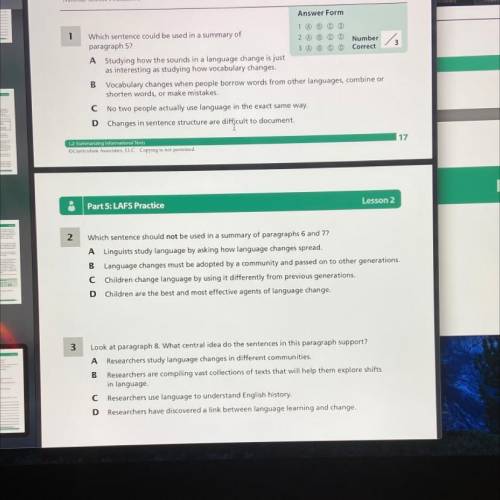.
Part 5: Common Core Practice Lesson 2
pea or many peas. At some point, people mi...

English, 29.03.2020 20:05 yanmanuel2215
.
Part 5: Common Core Practice Lesson 2
pea or many peas. At some point, people mistakenly assumed that the word pease was the plural form of pea, and a new word was born. While vocabulary can change quickly, sentence structure—the order of words in a sentence—changes more slowly. Yet it’s clear that today’s English speakers construct sentences very differently from Chaucer and Shakespeare’s contemporaries (see [table] above). Changes in sound are somewhat harder to document, but at least as interesting. For example, during the so-called “Great Vowel Shift”1 500 years ago, English speakers modified their vowel pronunciation dramatically. This shift represents the biggest difference between the pronunciations of so called Middle and Modern English.
Agents of Change
6 Before a language can change, speakers must adopt new words, sentence structures and sounds, spread them through the community and transmit them to the next generation. According to many linguists—including David Lightfoot, NSF2 assistant director for social, behavioral and economic sciences—children serve as agents for language change when, in the process of learning the language of previous generations, they internalize it differently and propagate a different variation of that language.
7 Linguists study language change by addressing questions such as these: Can we trace the evolutionary path of a language? How do language changes spread through communities? How do historical circumstances influence language change? What is the relationship between language learning and change?
Paths of Change
8 NSF researcher Anthony Kroch of the University of Pennsylvania is trying to understand how language change spreads through populations. With collaborator Beatrice Santorini, he is compiling an electronic collection of Modern English texts covering the time period from 1700 to 1914 (the beginning of World War I). The completed “corpus,” as it is known, will complement three others created independently over the past decade by researchers from the University of Pennsylvania and the University of York, England. The existing works—which span 900 years of English history—contain more than 4.5 million words of text carefully tagged and annotated for linguistic features. The publicly available collection gives researchers a standardized, searchable document to track changes in the English language over time. It helps them explore language shifts in a historical context and examine the link between language learning and change.
1 During the Great Vowel Shift of the fifteenth through the eighteenth centuries, English speakers gradually changed the way they pronounced vowels.
2 National Science Foundatio


Answers: 2


Another question on English

English, 21.06.2019 21:00
When greg came home for lunch, he realized that his air conditioner was broken. fragment, run on or complete sentence?
Answers: 2

English, 22.06.2019 04:00
Why does the author of exploring the titanic give background information about his youth and education? to show his lifelong love for the ocean
Answers: 1

English, 22.06.2019 06:30
The last part of the beowulf excerpt recounts how grendel flees into the darkness after suffering a fatal would from beowulf. what part of freytags pyramid best fits this section of the story
Answers: 3

English, 22.06.2019 08:30
Which best explains rev. simon hosack’s reaction to stanton’s feelings about behaving like a boy?
Answers: 3
You know the right answer?
Questions

Mathematics, 03.12.2020 21:40

Engineering, 03.12.2020 21:40

Mathematics, 03.12.2020 21:40

Mathematics, 03.12.2020 21:40

History, 03.12.2020 21:40


Mathematics, 03.12.2020 21:40

Social Studies, 03.12.2020 21:40




Biology, 03.12.2020 21:40

Advanced Placement (AP), 03.12.2020 21:40


English, 03.12.2020 21:40


Mathematics, 03.12.2020 21:40


English, 03.12.2020 21:40

Law, 03.12.2020 21:40



